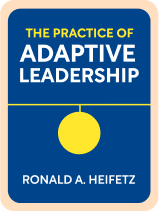

This article is an excerpt from the Shortform book guide to "The Practice of Adaptive Leadership" by Ronald A. Heifetz. Shortform has the world's best summaries and analyses of books you should be reading.
Like this article? Sign up for a free trial here .
Are you looking for The Practice of Adaptive Leadership quotes? What are some of the most noteworthy passages worth revisiting?
In their book The Practice of Adaptive Leadership, leadership experts Ronald A. Heifetz, Alexander Grashow, and Marty Linsky teach you how to lead your organization through the difficult, uncomfortable, and sometimes dangerous process of adaptation.
Below is a selection of The Practice of Adaptive Leadership quotes with explanations.
The Practice of Adaptive Leadership: Quotes by Ronald A. Heifetz
In The Practice of Adaptive Leadership, Ronald A. Heifetz, Alexander Grashow, and Marty Linsky teach you how to lead adaptively. You’ll learn how to diagnose adaptive challenges, create effective interventions, and push your organization—and yourself—further than you ever thought possible.
The following The Practice of Adaptive Leadership quotes highlight some of the key lessons.
“The most common leadership failure stems from trying to apply technical solutions to adaptive challenges.”
The most common reason change initiatives fail is because they attempt to apply a technical solution to an adaptive problem. Therefore, the first step when approaching a problem is to determine if it’s technical or adaptive. If the problem falls into any of the following archetypes, it’s probably adaptive:
- Contradiction between people’s actions and words. For example, during the civil rights movement, many Americans spoke about valuing equal opportunity but didn’t challenge segregation when they encountered it in daily life.
- Conflicting priorities. For example, a start-up might need employees to work long hours but also value its employees’ work-life balance and want them to be able to go home and spend time with their families.
- Filtering: when people keep their potentially inflammatory thoughts and impressions to themselves. For example, employees may only bring up ideas they know their boss will agree with, instead of ideas they think will be most helpful to the business.
- Work avoidance. Because adaptive problems are hard to solve, often people want to avoid dealing with them—for example, they might blame the messenger rather than address the message. Sometimes, it’s easier to see work avoidance techniques than an adaptive problem, so if you notice them, you can work backward to figure out what the problem is.
“To diagnose a system or yourself while in the midst of action requires the ability to achieve some distance from those on-the-ground events. We use the metaphor of “getting on the balcony” above the “dance floor” to depict what it means to gain the distanced perspective you need to see what is really happening.”
Diagnosing adaptive challenges requires that you distance yourself from the immediate happenings. This is done by taking a birds-eye view of three things:
- your organization’s adaptive capacity and the people within it;
- your own adaptive leadership abilities;
- the specific adaptive challenges you and your organization are facing
“If you find what you do each day seems to have no link to any higher purpose, you probably want to rethink what you’re doing.”
Organizational purpose is the grand vision that pulls the different functions of an organization together. The problem is that many businesses lose sight of their purpose as circumstances get in the way. The authors suggest three techniques for staying true to your purpose:
Technique #1: Regularly remind yourself of your purpose
1. Use a physical object to symbolize your purpose. Choose something you see every day, and for extra accountability, something that’s public, so people will check in with you about your progress.
2. Add purpose reminders to existing rituals. You already have rituals in your personal and professional life that you do regularly—if you can imbue them with purpose, you’ll encourage yourself to connect with it regularly.
3. Start new rituals. You can design a ritual entirely around a purpose.
Technique #2: Reconcile organizational purposes
Everyone in your organization holds purposes, and they may not all be the same. Figuring out how these purposes all fit together will prevent them from conflicting with each other as you tackle adaptive change.
Reconciling purposes can be uncomfortable—giving ground feels disloyal to the purpose—but your only other choices are to keep quiet about your purpose (and make no change) or leave the organization for one that shares the same purpose.
Technique #3: Reflect on ethics
The third technique is to consider how far you’re willing to go to achieve your purpose, because pursuing your purpose can lead to ethical dilemmas. For example, if the most effective intervention is to do something morally questionable, should you do it?
There’s no formula to determine the ethical benefits and costs when choosing a course of action—you have to decide for yourself. Consider the following two factors when making your decision:
1. Scope of harm to others. As we’ve learned, adaptive change inevitably creates a loss for certain parties. Consider how much harm you’re prepared to do in the name of your purpose.
2. Scope of harm to yourself. When you sacrifice a value or loyalty, you’ll damage your self-image. Consider how much harm you’ll wreck on yourself if you do things that feel wrong.
Technique #4: Hold both purpose and ambition
The fourth technique for maintaining your momentum during adaptive change is to embrace your ambitions and your purpose to authentically be your whole self.
You might feel embarrassed about your purpose (some industries paint purpose-servers as “do-gooders”) or guilty about your ambitions (some industries frown on the selfishness required in ambition). Don’t let these feelings limit you—there’s no reason you can’t serve both your ambition and a purpose that goes beyond yourself. Sometimes there will be moments of conflict (for example, you need to work late one night so can’t spend time with your family) but for the most part, you can have both.
Technique #5: Avoid pitfalls
The last technique to maintain your purpose is to watch out for traps. There are four pitfalls to avoid when it comes to serving your purpose:
1. Single-mindedness. When you get so committed to your purpose that you can’t see beyond it, you start to become insensitive to opposition and compromise, which could ultimately doom your purpose.
2. Martyrdom. Being “killed” (fired, in a professional context) for your purpose might be something you’re willing to risk if you’re truly committed to it. However, martyrdom doesn’t further your purpose—once you’re out of the way, people can forget about you and your purpose, and it’ll never be realized.
3. Self-righteousness. If you’re so vocal about your purpose and its rightness that you annoy people, they can become resistant to it for three reasons:
- They like to oppose things.
- They’ve had bad experiences with self-righteous authority in the past.
- They can’t take any ownership of the purpose because you have it all.
4. Overemphasis. People will get tired of talking about the purpose if you bring it up too often. Only remind them of it when it’s relevant.

———End of Preview———
Like what you just read? Read the rest of the world's best book summary and analysis of Ronald A. Heifetz's "The Practice of Adaptive Leadership" at Shortform .
Here's what you'll find in our full The Practice of Adaptive Leadership summary :
- How to deal with unknown solutions that require innovation, experimentation, and adaptation
- How to determine if a problem is technical or adaptive
- Five tips for launching initiatives to address adaptive challenges






